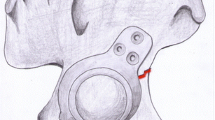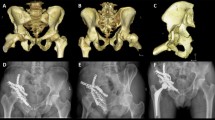Abstract
Purpose
This study examined the complications and outcomes of geriatric acetabular fractures treated with open reduction internal fixation (ORIF) and total hip arthroplasty (THA) performed via combined ilioinguinal or anterior intrapelvic (AIP) approach to acetabulum and anterior approach to the hip.
Methods
Eight patients with a fracture of the acetabulum were treated at a Level I trauma center between 2010 and 2019 with combined ORIF/THA using an ilioinguinal or AIP approach for the acetabulum and a separate anterior approach to the hip. Wound dehiscence, peri-incisional skin necrosis, surgical site infection, dislocation, fracture union, acetabular component stability, and heterotopic ossification (HO) were utilized as outcome measures. Merle d'Aubigné–Postel scores were collected for the six patients that had one-year minimum follow-up.
Results
The mean patient age was 77 years. Four patients had anterior wall fractures, two had associated both column fractures, and two had anterior column–posterior hemitransverse fractures. All fractures healed with stable fixation of the acetabular component by 6 months. There were no instances of skin necrosis, dislocation, infection, or re-operation. One patient had a superficial wound dehiscence that resolved with local wound care. One patient developed radiographic HO but was clinically asymptomatic. The mean Merle d'Aubigné–Postel score was 15.8 (range = 14–16).
Conclusions
Our small series of geriatric patients with fracture of the acetabulum treated with combined ORIF/THA, via the ilioinguinal or AIP approach with a separate anterior approach to the hip, demonstrates satisfactory outcomes with low complications after one-year of follow-up. Further research of these challenging injuries with more patients is warranted in order to determine the subset of fracture types best treated with this method and THA survivorship.




Similar content being viewed by others
References
Daurka JS, Pastides PS, Lewis A, Rickman M, Bircher MD (2014) Acetabular fractures in patients aged > 55 years: a systematic review of the literature. Bone Joint J 96-B:157–163
Borg T, Hernefalk B, Hailer NP (2019) Acute total hip arthroplasty combined with internal fixation for displaced acetabular fractures in the elderly: a short-term comparison with internal fixation alone after a minimum of two years. Bone Joint J. 101B:478–483
Lont T, Nieminen J, Reito A, Pakarinen TK, Pajamäki I, Eskelinen A et al (2019) Total hip arthroplasty, combined with a reinforcement ring and posterior column plating for acetabular fractures in elderly patients: good outcome in 34 patients. Acta Orthop 90:275–280
Letournel E (1980) Acetabulum fractures: classification and management. Clin Orthop Relat Res 151:81–106
Matta JM (2006) Operative treatment of acetabular fractures through the ilioinguinal approach: a 10-year perspective. J Orthop Trauma 20:S20–S29
Chen K, Ji Y, Huang Z, Navinduth R, Yang F, Sun T et al (2018) Single modified ilioinguinal approach for the treatment of acetabular fractures involving both columns. J Orthop Trauma 32:e428–e434
Beaulé PE, Griffin DB, Matta JM (2004) The Levine anterior approach for total hip replacement as the treatment for an acute acetabular fracture. J Orthop Trauma 18:623–629
Lannes X, Moerenhout K, Duong HP et al (2020) Outcomes of combined hip procedure with dual mobility cup versus osteosynthesis for acetabular fractures in elderly patients: a retrospective observational cohort study of fifty one patients. Int Orthop. https://doi.org/10.1007/s00264-020-04757-w
Herscovici D, Lindvall E, Bolhofner B, Scaduto JM (2010) The combined hip procedure: open reduction internal fixation combined with total hip arthroplasty for the management of acetabular fractures in the elderly. J Orthop Trauma 24:291–296
Lin C, Caron J, Schmidt AH, Torchia M, Templeman D (2015) Functional outcomes after total hip arthroplasty for the acute management of acetabular fractures: 1- to 14-year follow-up. J Orthop Trauma 29:151–159
Hagen JE, Weatherford BM, Nascone JW, Sciadini MF (2015) Anterior intrapelvic modification to the ilioinguinal approach. J Orthop Trauma 29(Suppl 2):S10–S13
Moed BR, Smith ST (1996) Three-view radiographic assessment of heterotopic ossification after acetabular fracture surgery. J Orthop Trauma 10:93–98
Tompkins GS, Jacobs JJ, Kull LR, Rosenberg AG, Galante JO (1997) Primary total hip arthroplasty with a porous-coated acetabular component. Seven-to-ten-year results. J Bone Joint Surg Am 79:169–176
Bosse MJ, Poka A, Reinert CM, Ellwanger F, Slawson R, McDevitt ER (1988) Heterotopic ossification as a complication of acetabular fracture. Prophylaxis with low-dose irradiation. J Bone Joint Surg Am. 70:1231–1237
D’Aubigne RM, Postel M (1954) Functional results of hip arthroplasty with acrylic prosthesis. J Bone Joint Surg Am 36A:451–475
Matta JM, Shahrdar C, Ferguson T (2005) Single-incision anterior approach for total hip arthroplasty on an orthopaedic table. Clin Orthop Relat Res 441:115–124
Manson TT (2020) Open reduction and internal fixation plus total hip arthroplasty for the acute treatment of older patients with acetabular fracture: surgical techniques. Orthop Clin N Am 51:13–26
Boraiah S, Ragsdale M, Achor T, Zelicof S, Asprinio DE (2009) Open reduction internal fixation and primary total hip arthroplasty of selected acetabular fractures. J Orthop Trauma 23:243–248
Mears DC, Velyvis JH (2002) Acute total hip arthroplasty for selected displaced acetabular fractures: two to twelve-year results. J Bone Joint Surg Am 84:1–9
Malhotra R, Gautam D (2019) Acute total hip arthroplasty in acetabular fractures using modern porous metal cup. J Orthop Surg (Hong Kong) 27:2309499019855438
Mouhsine E, Garofalo R, Borens O, Blanc CH, Wettstein M, Leyvraz PF (2004) Cable fixation and early total hip arthroplasty in the treatment of acetabular fractures in elderly patients. J Arthroplasty 19:344–348
Kistler BJ, Sagi HC (2015) Reduction of the posterior column in displaced acetabulum fractures through the anterior intrapelvic approach. J Orthop Trauma 29(Suppl 2):S14–S19
Wang Z, Hou JZ, Wu CH, Zhou YJ, Gu XM, Wang HH et al (2018) A systematic review and meta-analysis of direct anterior approach versus posterior approach in total hip arthroplasty. J Orthop Surg Res 13:229
Barrett WP, Turner SE, Leopold JP (2013) Prospective randomized study of direct anterior vs postero-lateral approach for total hip arthroplasty. J Arthroplasty 28:1634–1638
Martusiewicz A, Delagrammaticas D, Harold RE, Bhatt S, Beal MD, Manning DW (2019) Anterior versus posterior approach total hip arthroplasty: patient-reported and functional outcomes in the early postoperative period. Hip Int. https://doi.org/10.1177/1120700019881413
Sheth D, Cafri G, Inacio MC, Paxton EW, Namba RS (2015) Anterior and anterolateral approaches for THA are associated with lower dislocation risk without higher revision risk. Clin Orthop Relat Res 473:3401–3408
Higgins BT, Barlow DR, Heagerty NE, Lin TJ (2015) Anterior vs. posterior approach for total hip arthroplasty, a systematic review and meta-analysis. J Arthroplasty. 30:419–434
Martin JR, Masonis JL, Mason JB (2020) Anatomic total hip component position is more reproducible with the direct anterior approach using intraoperative fluoroscopy. Arthroplast Today 6:777–783
Jewett BA, Collis DK (2011) High complication rate with anterior total hip arthroplasties on a fracture table. Clin Orthop Relat Res 469:503–507
Author information
Authors and Affiliations
Corresponding author
Ethics declarations
Conflict of interest
The authors declare that they have no conflict of interest.
Ethical approval
This article contained only de-identified human participant information and was approved by an institutional review board.
Additional information
Publisher's Note
Springer Nature remains neutral with regard to jurisdictional claims in published maps and institutional affiliations.
Rights and permissions
About this article
Cite this article
Chen, M.J., Wadhwa, H. & Bellino, M.J. Sequential ilioinguinal or anterior intrapelvic approach with anterior approach to the hip during combined internal fixation and total hip arthroplasty for acetabular fractures. Eur J Orthop Surg Traumatol 31, 635–641 (2021). https://doi.org/10.1007/s00590-020-02810-3
Received:
Accepted:
Published:
Issue Date:
DOI: https://doi.org/10.1007/s00590-020-02810-3




